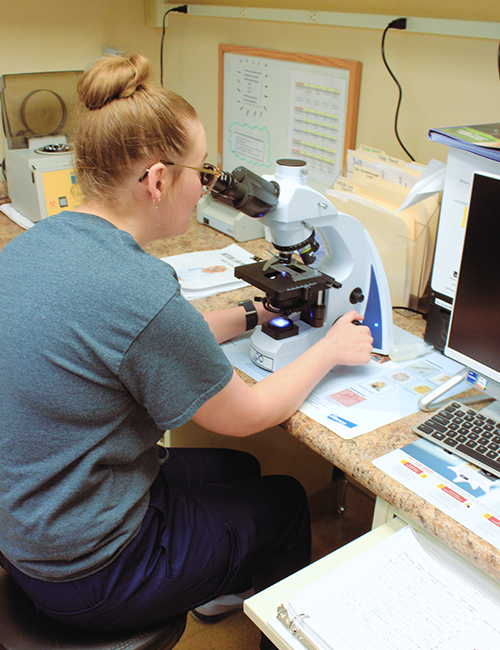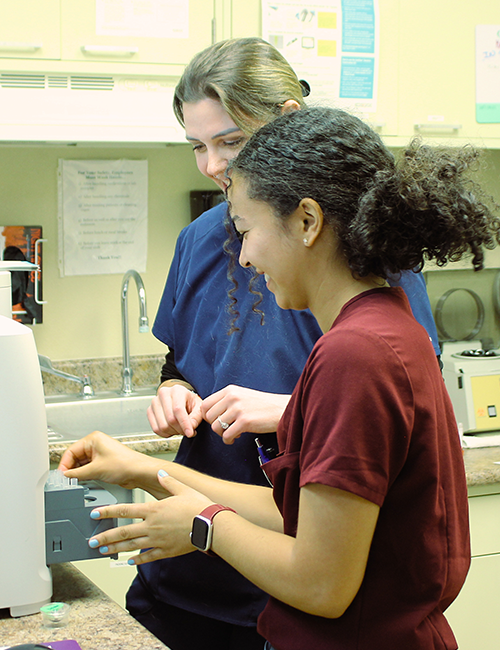Veterinary Services
Pet Diagnostics at Wellington Veterinary Hospital in Wellington, CO
Our advanced technology and skilled team at Wellington Veterinary Hospital quickly diagnose and treat your pet’s health issues. Comprehensive diagnostics are the first step in giving your pet the best possible care!
Advanced Pet Diagnostics Services in Wellington, CO
Accurate diagnostics are critical in veterinary medicine, enabling us to identify the root cause of your pet’s symptoms and develop effective treatment plans targeting their specific needs. Our pet diagnostics services in Wellington, CO, encompass a range of advanced imaging and testing techniques, each designed to uncover underlying health issues that may not be visible through a physical examination alone.
Recognizing Signs for Pet Diagnostic Services
Identifying when your pet may require diagnostic services is crucial for their health. Look out for symptoms such as persistent vomiting or diarrhea, unexplained weight loss, lethargy, changes in appetite or thirst, difficulty breathing or coughing, skin lesions or lumps, excessive scratching or licking, and behavioral changes. These signs indicate a need for evaluation at Wellington Veterinary Hospital in Wellington, CO.
Our comprehensive diagnostic tools include ultrasound, radiology (X-rays), and endoscopy. Early detection through these methods allows for prompt treatment and better health outcomes for your pet.
Contact us if your pet exhibits any concerning symptoms. Trust our expertise in providing compassionate care.


Laboratory
We frequently utilize our in-house laboratory for diagnosing sick patients and screening for diseases. Pre-surgical and healthy pet bloodwork as well as parasite testing are typically outsourced to our reference laboratories.
Regular blood work is essential for monitoring your pet’s well-being and establishing their baseline levels. That’s why we conduct annual blood work for adults pets and biannually for pets aged 7 and above. These baseline levels enable us to quickly identify subtle changes that might indicate the presence of a disease.
Laboratory Tests
- Complete blood cell count (CBC)
- Blood chemistry panels
- Urinalysis
- Fecal exam
- Heartworm test and tick-borne disease screening
- Feline leukemia FeLV) and feline immunodeficiency virus (FIV) tests
- Cytology (skin, ears, etc.)
- And more!
Digital Radiology
Radiology, or X-ray imaging, is an essential tool in veterinary diagnostics. X-rays create detailed images of your pet’s internal structures, including bones, heart, lungs, and abdominal organs. This non-invasive technique helps us detect fractures, tumors, foreign objects, and other anomalies. With advancements in digital X-ray technology, we can now enhance and manipulate images for more accurate diagnoses.
Benefits of Radiology
- Non-Invasive Imaging: Utilizes advanced technology to provide detailed internal views, minimizing the need for invasive procedures.
- Quick Results: Enables veterinarians to swiftly diagnose conditions and formulate effective treatment strategies.
- Versatile Applications: Used across various specialties to diagnose a broad spectrum of health issues such as:
- Fractures
- Joint injuries
- Orthopedic conditions
- Foreign body ingestion
- Abdominal obstructions
- Bladder and kidney stones
- Heart disease
- Dental disease
- And more!
Ultrasonography
Ultrasonography, or ultrasound, uses high-frequency sound waves to create images of your pet’s internal organs and tissues. This technique is particularly effective for examining soft tissues, such as the heart, liver, kidneys, and intestines. When ultrasound is used to assess the heart, the procedure is called an echocardiogram. Ultrasound is also invaluable for monitoring pregnancies and guiding biopsies. Our collaboration with imaging specialists ensures that you receive the most accurate and detailed results.
Benefits of Ultrasound
- Safe and Painless Imaging: Ultrasonography involves no radiation exposure, ensuring safety and suitability for frequent examinations.
- Real-Time Imaging Capabilities: Provides immediate visualization of organ function and structure, aiding in prompt diagnosis and treatment planning.
- Versatile Diagnostic Applications: Extensively used for both diagnostic purposes and guiding therapeutic interventions due to its detailed imaging capabilities and non-invasive nature.
Endoscopy
Endoscopy involves using a flexible or rigid fiberoptic instrument to visually examine the internal organs. A tiny camera at the end of the endoscope transmits live images, allowing us to detect abnormalities and collect tissue samples without the need for invasive surgery. Endoscopy is often used for diagnosing gastrointestinal issues, removing foreign objects, and performing biopsies. By collaborating with travelling Internal Medicine specialists, we guarantee that you will receive precise and comprehensive results in house at Wellington Veterinary Hospital.
Benefits of Endoscopy
- Minimally Invasive Procedure: Endoscopy reduces the need for traditional surgical interventions, offering a less invasive option for diagnosing and treating internal conditions.
- Reduced Anesthesia Risk: Shorter procedure times mean less exposure to anesthesia, lowering the associated risks and ensuring safer outcomes for your pet.
- Enhanced Recovery: By minimizing tissue trauma and post-operative care requirements, endoscopy promotes quicker recovery times and reduces the need for prolonged hospital stays.
Visit Wellington Veterinary Hospital Today
Choose Wellington Veterinary Hospital in Wellington, CO, for advanced pet diagnostics that provide clarity and insight into your pet’s health. Our advanced diagnostic tools and experienced team ensure accurate and timely assessments, guiding effective treatment plans. Whether your companion needs examination using radiology, ultrasonography, or endoscopy, trust us to deliver comprehensive care with compassion.

